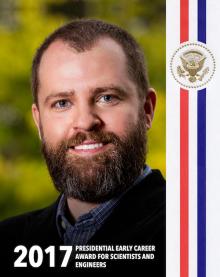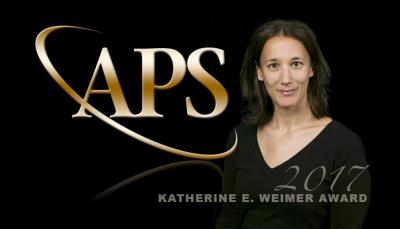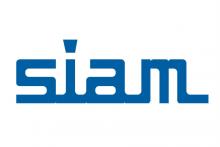The LDRD Program funds leading-edge science and technology research while maintaining a high standard of excellence and profound sense of purpose. This combination of creativity and challenge attracts bright young scientists from around the world and provides technical staff with an opportunity to maintain the currency of their knowledge and skills. The result is a first-class catalog of technical achievements that break new ground and set new standards.
It’s no surprise, then, that every year, Livermore’s LDRD principal investigators win numerous awards and recognition for their LDRD-funded work. FY17 proved a particularly bountiful year as many current and recent LDRD researchers received accolades and honors, magnifying the prestige of the Program, the Laboratory, and the DOE. The following short list of stories attests to the exceptional talents of these researchers and underscores the vitality of Livermore’s LDRD Program.
Project: Direct Ink Writing of Bulk Metallic Glasses (17-FS-005)
Project: Additive Manufacturing of Nanometer-Scale Porous Metals (17-FS-036)
Principal investigator: Eric Duoss
Eric Duoss was one of two Livermore researchers named by President Obama for the prestigious Presidential Early Career Award for Scientists and Engineers (PECASE), as announced in Washington D.C. January 9, 2017. The PECASE is coordinated by the Office of Science and Technology Policy within the Executive Office of the President and represents the highest honor the U.S. government awards to scientists and engineers in the early stages of their careers.
PECASE judges look for innovative research and community service, and Duoss meets both criteria. A member of the Lab's technical staff since 2010, he is known for his research in advanced materials and manufacturing combined with micro-architected design, including groundbreaking work in numerous LDRD projects. According to Duoss, his PECASE “would not have been possible without LDRD.”
In addition to his programmatic work, Duoss has dedicated himself to educating the younger generation of scientists and engineers about STEM pathways, volunteering countless hours and conducting frequent Lab tours for students and teachers. Duoss confirmed the early career award will encourage him to emphasize creative avenues in his research and continue mentoring youth: "This is truly a recognition of the kind of environment we have, that early career scientists and engineers can do creative and exciting things. It's a testament to the extraordinary work I've been privileged to be a part of and the team members I've been fortunate to work with.… I hope I can be an innovative engine to spur thought and get people to think of new ideas."
Duoss was among 100 awardees, 13 of whom were from the Department of Energy. Said then-president Obama, "I congratulate these outstanding scientists and engineers on their impactful work.… These innovators are working to help keep the United States on the cutting edge, showing that federal investments in science lead to advancements that expand our knowledge of the world around us and contribute to our economy."
Project: Measuring Dark Energy with the Large Synoptic Survey Telescope (13-ERD-063)
Project: Image Analysis for Dark Energy and Space Surveillance Applications (16-ERD-013)
Principal investigator: Michael Schneider
Livermore’s Michael Schneider is an astrophysicist and principal investigator for science research for the Large Synoptic Survey Telescope (LSST), the NSF’s wide-field survey telescope currently under construction in northern Chile. Based on his LDRD-funded research in dark energy, Schneider has garnered a DOE Office of Science 2017 Early-Career Research Award, which bolsters the nation's scientific workforce by providing support to exceptional researchers during the critical early-career years, when many scientists do their most formative work. Under the program, researchers based at DOE national laboratories receive grants of $500,000 per year for five years to cover their annual salary plus research expenses. Schneider plans to use the funding for his dark-energy quest.
A primary approach in the search for dark energy involves gravitational lensing, which traces mass structure versus cosmic time and may serve as a dark-energy probe. Gravitational lensing causes the magnification and distortion of a background galaxy by mass along line of sight. By using the billion-pixel camera on the LSST, Schneider will be able to map the entire visible sky in just three days.
According to Schneider, "When we figure out what dark energy is, it's possible we'll understand something new about the Big Bang. In fact, we may find we are just one of many universes."
Project: Extreme Nonlinear Optics of Plasmas (16-LW-022)
Principal investigator: Pierre Michel
Scientist Pierre Michel, an expert in laser–plasma physics at Livermore’s National Ignition Facility (NIF), received an award from the Laboratory’s Early- and Mid-Career Recognition Program in 2017. Michel was recognized by the Laboratory for his game-changing research into crossbeam energy transfer, including an LDRD project that led to a theory on the establishment of a steady state for refractive microstructures imprinted by lasers on plasmas. The Program recognizes the scientific and technical accomplishments, leadership, and promise demonstrated by Laboratory scientists and engineers within 5–20 years after their most recent degree. Winners receive a cash award and funding for one year (equivalent to 20 percent of their time) to pursue research activities in their area of expertise. This major award is not Michel’s first; he also won the 2015 Edouard Fabre Prize for contributions to the physics of laser-driven Inertial Confinement Fusion and laser-produced plasmas.
From left: Frank Graziani, Hye-Sook Park, Bob Deri and Rick Ryerson.
In May 2017, four Livermore researchers were accorded the title Distinguished Members of Technical Staff (DMTS) by Laboratory director Bill Goldstein for their extraordinary scientific and technical contributions to the Laboratory and its missions, as acknowledged by their peers, the institution, and the larger professional community.
In earning the DMTS designation, Bob Deri of the Engineering Directorate, Frank Graziani of the Weapons and Complex Integration Directorate, Hye-Sook Park of the NIF and Photon Science Directorate, and Rick Ryerson of the Physical and Life Science Directorate reached the highest technical-staff level achievable by a scientist or engineer at the Laboratory.
All began their careers at the Laboratory as LDRD researchers and together have been the principal investigators on a combined 36 projects. The classification allows recipients to remain focused on solutions to critical mission areas of the Laboratory, and the 2017 recipients continue to participate in the LDRD Program as proposal reviewers or mentors to early career investigators.
The DMTS classification was defined by Bell Labs in 1982 and implemented at Lawrence Livermore to serve as a career ladder for scientists and engineers by recognizing scientific, technological, and engineering excellence through distinction and compensation. Only a few recipients are selected annually—like other laboratories and industry, Lawrence Livermore expects its DMTS population to remain at two–three percent of eligible technical staff.
Project: A Compact Femtosecond Hard X-Ray Source for Materials Characterization and High-Energy-Density Science (13-LW-076)
Project: Extending Laser-Driven X-Ray Sources to High-Energy-Density Science Facilities (16-ERD-024)
Principal investigator: Félicie Albert
FY17 was a banner year for Livermore physicist Félicie Albert.
Since joining the Laboratory as a postdoc in 2008, Albert, an expert in ultrafast x-ray sources and laser–plasma interactions, has been at the forefront of some of the most high-impact research in her field. In work funded by the LDRD Program, and later by the DOE Office of Science's Early-Career Research Program, Albert led an international team pursuing a new regime in laser research. Albert and the team spent over two years experimenting with new ways to generate x-rays capable of probing the size, density, pressure, and composition of highly transient states of matter, such as those found in fusion plasmas and the cores of planets. The team showed how betatron x-ray radiation driven by short-pulse lasers has broad application across fields—for example, for biological and medical purposes, such as x-ray phase-contrast imaging and hard x-ray radiography, and in studying the dynamics of high-energy-density plasmas and warm dense matter (a state of near-solid densities at temperatures found in the cores of giant planets like Jupiter).
For this and other research, Albert was awarded the 2017 Edouard Fabre Prize, which honors contributions to the physics of laser-driven Inertial Confinement Fusion (ICF) and laser-produced plasmas. Albert shares the award with collaborator Alexis Casner, research director of the French Alternative Energies and Atomic Energy Commission (CEA). Named for a founder of ICF, the prize is awarded to active researchers within 15 years of their doctoral degree and sponsored by the European Cooperation in Science and Technology Network for Inertial Confinement Fusion.
In further recognition, Albert received the 2017 Katherine E. Weimer Award from the American Physical Society, Division of Plasma Physics (DPP) for “pioneering development and characterization of x-ray sources from laser-wakefield accelerators and Compton-scattering gamma-ray sources for applications in high-energy-density science and nuclear-resonance fluorescence." The award commemorates Katherine Weimer, a pioneering research physicist at the Princeton Plasma Physics Laboratory at Princeton University, and was established by DPP to recognize and encourage outstanding achievement in plasma-science research by women physicists in their early careers. Albert was also selected by APS as an outstanding referee in 2015.
Validating the seminal significance of her LDRD-funded work, in 2017 Albert achieved the plasma-physics equivalent of going viral. Her paper, “Applications of Laser Wakefield Accelerator-Based Light Sources,” published by Institute of Physics (IOP) Science, was among the most popular downloads of the year, earning a spot in what IOP calls its “exclusive highlights of 2016 collection” and made available via open access for a year. The paper describes the wide-ranging potential for laser-accelerated light sources in diverse fields, including radiography, nuclear medicine, and high-energy-density science, as well as defense and industrial applications such as energy storage and the detection of explosives and drugs in cargo.
Albert’s work with LDRD is an outstanding example of the value of the Program, which aims to attract and support talented, early-career scientists and engineers whose innovative work advances national missions and strengthens the Laboratory’s capabilities and culture of excellence.
Project: Multiple-Rate Integrators for Differential Equations (17-ERD-035)
Principal investigator: Carol Woodward
Mathematician Carol Woodward became the first Livermore employee named a fellow of the Society for Industrial and Applied Mathematics (SIAM), in recognition of her mathematical algorithms and software for faster, more accurate simulations of complex physical phenomena. Woodward, a Laboratory employee since 1996, is a lead for the Nonlinear Solvers and Differential Equations Project and has applied her algorithms to applications as diverse as subsurface flow, particle transport, fusion, climate science, supernovae, and materials science. Woodward was one of 28 SIAM Fellows selected this year worldwide, and one of only two from DOE laboratories. “It’s very exciting,” Woodward said of her elevation. “It’s a recognition that the applied mathematics work that goes on at the Laboratory is critical…Our Center for Applied Scientific Computing is very well known internationally, but more fellows at the Laboratory is good for our image and recruiting efforts.”
Project: New Generation X-Ray Optics: Focusing Hard X-Rays (14-ERD-032)
Project: Multilayer Thin-Film Science for Core Missions (12-ERD-055)
Project: Advanced Multilayer Systems for National Security (17-SI-001)
Principal investigator: Regina Soufli
Livermore physicist Regina Soufli has been elected an SPIE senior member. SPIE, the International Society for Optics and Photonics, bestows the senior-member designation on individuals who have distinguished themselves by their professional experience and active involvement within the optics community and SPIE. Soufli is recognized for her scientific achievements in extreme ultraviolet/x-ray optics and nanoscale multilayer interference coatings, research that was supported by the LDRD Program. At LLNL, she has led programs that developed first-of-a-kind optics for photolithography, NASA solar physics and astrophysics missions, x-ray free-electron lasers, and other high-energy-physics applications. She has also performed pioneering research in x-ray interactions with matter. Soufli serves as a principal investigator of an LDRD strategic initiative to develop next-generation, multilayer optical coatings for higher-energy experiments in the “hard” x-ray spectrum. In 2013, she was among a team that received a Group Achievement Award from NASA; she was elected a fellow of the Optical Society (OSA) in 2014.Soufli's career, from her doctoral research at the Center for X-Ray Optics at Lawrence Berkeley National Laboratory, to her work at the Harvard–Smithsonian Center for Astrophysics, to her investigations at NASA's Chandra X-ray Observatory, to the present, has yielded methodologies and experimental values for the x-ray refractive index of materials that are now commonly used as benchmarks and references in the global scientific community. "I am extremely grateful to the Lab and my colleagues," she said. "None of these successes would have happened if it were not for the Lab and the support we have here.”
Project: Scalable Computational Learning Architectures (16-ERD-039)
Principal investigator: Brian Van Essen
LLNL researchers won big at the 2017 SuperComputing Conference in Denver, taking home an HPCwire Editor’s Choice Award for their work in applying high-performance computing (HPC) to complex challenges. The publication honored Laboratory scientists involved in a partnership between the DOE national laboratories and the National Cancer Institute with an award for Best Use of AI (artificial intelligence) for CANDLE (CANcer Distributed Learning Environment), a project that applies machine learning to personalized cancer medicine and employs the results of research supported by the LDRD Program.
Project: Rapid Detection and Characterization of Emerging Foreign Animal-Disease Pathogens (14-ERD-081)
Principal investigator: Crystal Jaing
The American Association of Veterinary Laboratory Diagnosticians has awarded a Journal of Veterinary Diagnostic Investigation paper coauthored by Livermore and Kansas State University researchers Best Full Manuscript of 2016. “Application of a Pathogen Microarray for the Analysis of Viruses and Bacteria in Clinical Diagnostic Samples from Pigs” presents the results of LDRD-supported research into next-generation diagnostics for detecting agricultural pathogens. The authors describe their efforts to evaluate the Lawrence Livermore Microbial Detection Array (LLMDA) for use in detecting pathogens from swine clinical samples and analyze the array’s sensitivity and specificity. For their research, the team evaluated known and unknown microbes in blood, oral fluid, and tonsils from pigs with co-infections of porcine reproductive and respiratory syndrome virus (PRRSV) and porcine circovirus-2 (PCV-2). (Note that many of the diseases affecting the commercial swine industry involve complex syndromes caused by multiple pathogens, including emerging viruses and bacteria.) The LLMDA easily identified PRRSV and PCV-2. One pivotal advantage of the Livermore-developed LLMDA over other detection technologies is that it can detect within 24 hours any bacteria or virus that has been previously sequenced. The authors predict that as the LLMDA technology’s cost decreases and throughput increases, it will be feasible to look at microarrays as everyday tools in the diagnostic laboratory.Project: A Short-Pulse, Laser-Driven Particle Beam Capability (17-ERD-039)
Principal investigator: Tammy Ma
A global spotlight was shone on Livermore physicist Tammy Ma at the World Economic Forum's (WEF) 2017 Meeting of the New Champions as she took the stage in Dalian, China with international leaders such as Wilfred Madius Tangau, Malaysia's minister of science, technology and innovation; Jean-Pierre Bourguignon, president of the European Research Council; and Andrei Fursenko, former minister of education and science for Russia and current aide to the president. The occasion was a panel discussion called “Science With(out) Borders,” which addressed how the global scientific community should collaborate in the wake of geopolitical tensions.Ma was one of 55 scientists worldwide invited to attend the WEF as part of the Young Scientists Class of 2017, a program honoring researchers under the age of 40 for groundbreaking work in various scientific fields. According to the WEF, “These individuals have demonstrated their commitment to public service and actively play a transformational role in integrating scientific knowledge into society for the public good.”
Ma, an experimental plasma physicist in Inertial Confinement Fusion and high-energy-density physics, has been with the Laboratory since receiving her doctorate from the University of California, San Diego, in 2012. She currently leads the X-Ray Analysis Group for Livermore's Inertial Confinement Fusion Program and several fusion experimental campaigns fielded on the National Ignition Facility. Her work, including several cutting-edge LDRD projects, has garnered the 2016 Stix Award for Outstanding Early Career Contributions to Plasma Research by the American Physical Society and the Presidential Early Career Award for Science and Engineering—the highest honor bestowed by the U.S. government on science and engineering professionals in the early stages of their independent research careers. She was recently named chair of the LDRD Program’s Laboratory-Wide Competition.

















